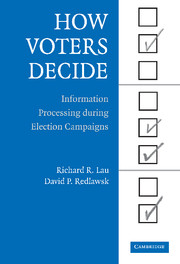Book contents
- Frontmatter
- Contents
- List of Tables and Figures
- Acknowledgments
- HOW VOTERS DECIDE
- I Theory and Methods
- II Information Processing
- III Politics
- IV Conclusion
- 12 A Look Back and a Look Forward
- Appendix A Detailed Examples of Decision Strategies in Action
- Appendix B How the Dynamic Information Board Works
- Appendix C Overview of Experimental Procedures
- Appendix D Detailed Decision Scripts
- Appendix E Calculating the On-line Evaluation Counter
- References
- Index
- Titles in the series
12 - A Look Back and a Look Forward
Published online by Cambridge University Press: 05 September 2012
- Frontmatter
- Contents
- List of Tables and Figures
- Acknowledgments
- HOW VOTERS DECIDE
- I Theory and Methods
- II Information Processing
- III Politics
- IV Conclusion
- 12 A Look Back and a Look Forward
- Appendix A Detailed Examples of Decision Strategies in Action
- Appendix B How the Dynamic Information Board Works
- Appendix C Overview of Experimental Procedures
- Appendix D Detailed Decision Scripts
- Appendix E Calculating the On-line Evaluation Counter
- References
- Index
- Titles in the series
Summary
Political scientists have for some time had a pretty good sense of why people vote the way they do, based on such factors as socioeconomic status, group affiliations, partisanship, and issue agreement. There have been arguments over the relative importance of these different antecedents of the vote – and in fact, they have probably changed over time – but most models can readily predict the direction of the vote. In a general election in our current era of somewhat renewed partisanship, simply knowing the party identification of a voter gives us a pretty good idea of how he or she will vote. So there does not seem to us to be much more to mine within this particular genre of voting research.
While traditional models of the vote do a reasonably good job of predicting election outcomes, they do not do as good a job explaining why voters do what they do. Traditional voting models take as given that voters process information, but they do little to open the black box that surrounds how information is acquired and used. They typically view the information environment as fixed and exogenous and give voters little role in shaping their own personal information environments. Thus, one of the goals of this book has been to shed light on the process of voter decision making during political campaigns, to try to understand what people actually do as they try to shape the political information they encounter, and how they use it to make sense of the choices they face.
- Type
- Chapter
- Information
- How Voters DecideInformation Processing in Election Campaigns, pp. 255 - 264Publisher: Cambridge University PressPrint publication year: 2006
- 1
- Cited by

